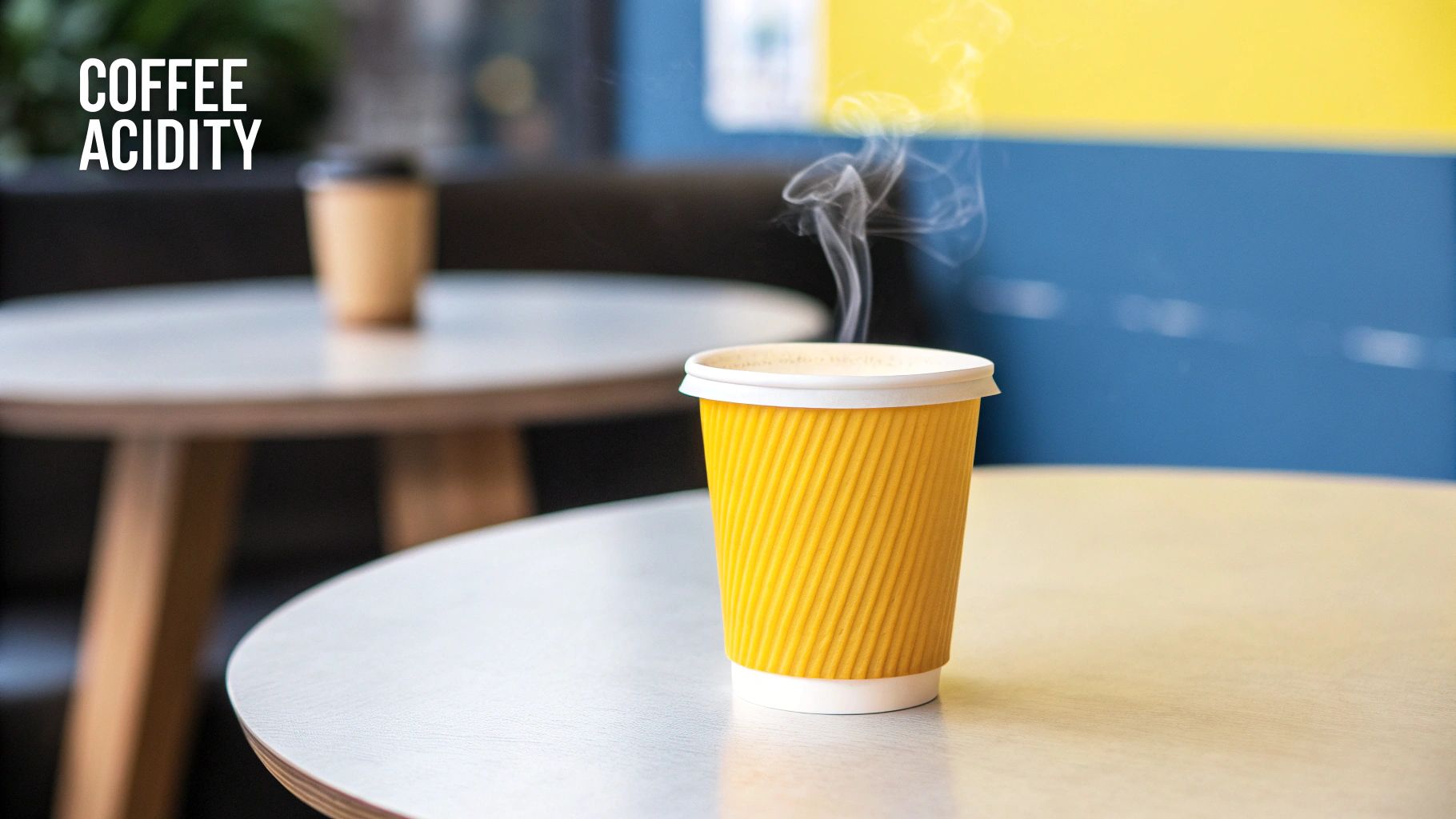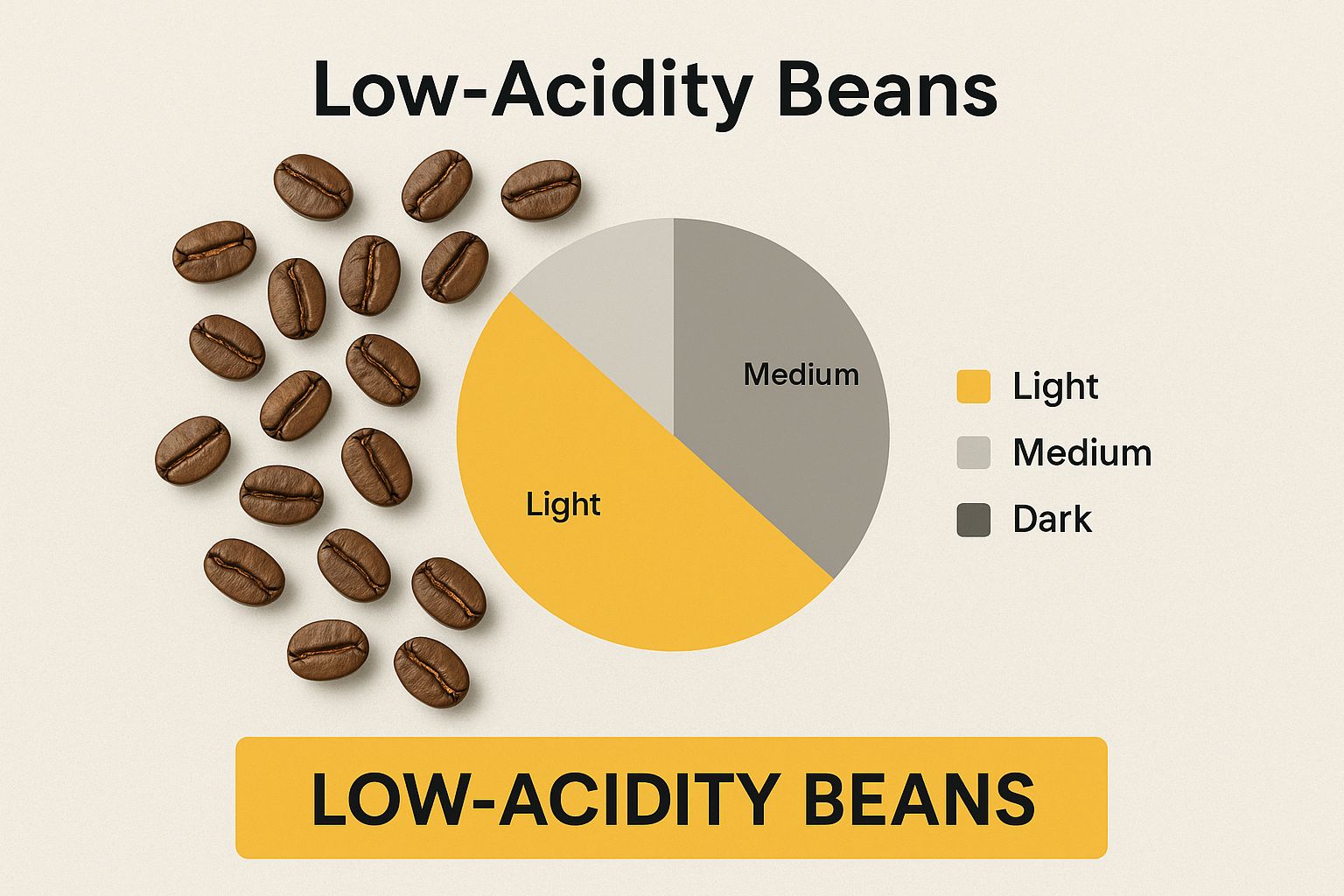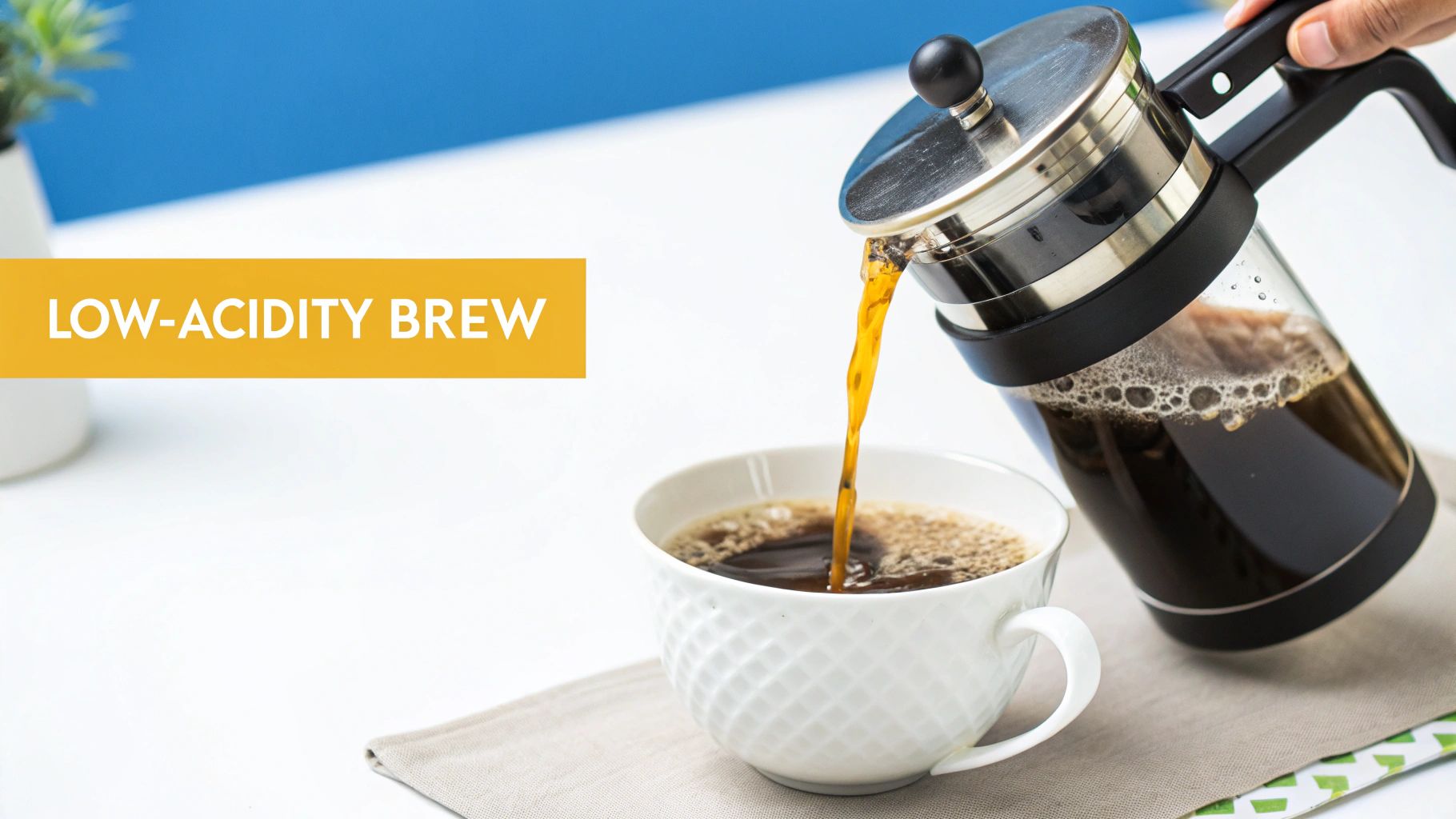That sharp, sour tang in your morning coffee can ruin the whole experience. If you need a quick fix, the fastest ways to mellow it out are grabbing some dark-roasted beans, switching to a cold brew, or just adding a splash of milk. These simple tweaks can make a world of difference right away.
Why Your Coffee Tastes Sour and How to Fix It

When you hear a barista talk about "acidity," they're usually describing the bright, fruity, and lively notes that make a specialty coffee pop. Think of the crispness of a green apple or the zesty flavor of a fresh berry—that’s the good kind of acidity. It adds complexity and separates a truly great cup from a flat, boring one.
But there's a very fine line between delightful brightness and just plain unpleasant sourness. If your coffee makes your face pucker in a bad way, something in your brew process went wrong. That sour taste is almost always a sign of under-extraction, which is just a fancy way of saying the water didn't have enough time to pull all the good stuff out of the coffee grounds.
What Causes That Sour Pucker?
So, what's really happening in the brewer to cause that sourness? It all comes down to the order of extraction. When you start brewing, the first compounds to dissolve are the acids, followed by the sugars, and finally the heavier, more bitter compounds. A perfectly balanced brew gets a little bit of everything.
Sourness happens when you stop the brew too early, leaving you with a cup full of acids but not enough of the sugars and other compounds to balance them out. The most common culprits are pretty simple:
- Your water isn’t hot enough. Hot water is way more efficient at extraction. If you're brewing below 195°F, you're likely leaving a lot of the sweet, desirable flavors behind in the grounds.
- Your grind size is too coarse. When coffee grounds are too big, water zips right through them without grabbing much flavor. It's like trying to catch rain in a net.
- You're rushing the brew time. The water needs enough time to hang out with the coffee grounds. Cutting the brew short means you’re only getting the first wave of flavor, which is mostly acidic.
Understanding the difference between good acidity (brightness) and bad acidity (sourness) is the first step. The goal isn't to kill all the acidity, but to balance it for a perfectly smooth, flavorful cup.
This guide will walk you through everything you can adjust—from the beans you buy to the way you brew—so you can dial in that ideal flavor every single time.
Choosing the Right Beans and Roast for Low Acidity
Your journey to a smoother, less acidic cup of coffee starts long before you ever turn on your brewer. In fact, the specific coffee you buy is arguably the biggest factor in determining the final acidity you taste. Everything from where the beans are grown to how they’re roasted lays the foundation for their entire flavor profile.
For example, beans grown at high altitudes in places like Ethiopia or Kenya often develop a bright, complex, and almost wine-like acidity. On the flip side, coffees from lower-altitude regions such as Brazil, Sumatra, and India are well-known for their low-acid, earthy, and full-bodied characteristics.
So, if you're hunting for a gentler brew, that’s your first clue: start by exploring beans from those origins.

As you can see, simply choosing beans from specific regions is a pretty straightforward way to get started on lowering the acidity of your coffee.
How Roast Level Transforms Acidity
While origin is a great starting point, the real game-changer is the roast level. As coffee beans tumble and heat up in the roaster, their chemical composition goes through a massive transformation. This is where you can truly dial in your preference for lower acidity.
Lighter roasts tend to preserve many of the coffee's original organic acids, like citric and malic acid, which give you those bright, fruity notes. But as the roast gets darker, these compounds begin to break down. This means darker roasts are naturally less acidic.
Pro Tip: Look for roast names on the bag like 'Full City,' 'Vienna,' 'French Roast,' or 'Italian Roast.' These all point to a darker roast profile designed to mute acidity and bring out deep, rich flavors of chocolate, nuts, and caramel.
The science backs this up, too. As the roast progresses from light to dark, acidic compounds decrease significantly, resulting in a coffee with a higher pH (which means lower acidity).
To make this easier to visualize, here's a quick reference guide.
Coffee Bean and Roast Acidity Guide
This table breaks down how different coffee characteristics generally line up with acidity levels, helping you make a quick choice at the store.
| Characteristic | Higher Acidity | Lower Acidity |
|---|---|---|
| Origin | High-altitude regions (Kenya, Ethiopia) | Low-altitude regions (Brazil, Sumatra) |
| Roast Level | Light or Medium Roast | Dark or French Roast |
| Flavor Notes | Citrus, Berry, Floral, Fruity | Chocolate, Nutty, Earthy, Smoky |
Think of this as your cheat sheet. When you're looking for low-acid coffee, just scan the bag for the characteristics in the "Lower Acidity" column.
Reading the Flavor Notes
Beyond the roast name, the flavor notes printed on the coffee bag are your best clues. These are the roaster's own descriptions of what you can expect to taste. Treat them like a roadmap to your perfect cup.
-
For lower acidity, look for bags with flavor notes like:
- Dark Chocolate or Baker's Chocolate
- Nutty (think Almond or Walnut)
- Toasted Marshmallow
- Earthy or Smoky
-
Steer clear of bags with flavor notes like:
- Lemon, Lime, or Citrus
- Berry or Stone Fruit (like Peach or Cherry)
- Floral or Tea-like
By paying attention to the bean's origin, roast level, and flavor descriptions, you can confidently pick a coffee that aligns with your low-acid goals. For a deeper dive into bean varieties, check out our guide on the different types of coffees. Choosing the right bag is the first and most impactful step you can take.
Master Your Brewing Technique to Lower Acidity

Even if you’ve picked out the perfect low-acid beans, the way you brew can completely change the final cup. Simple tweaks to your routine can dial back that sourness and bring smoother flavors to the forefront, giving you total control over how your coffee tastes.
One of the biggest game-changers? Switching up your brew method entirely. If you want the ultimate low-acid experience, cold brewing is the way to go.
The process is simple: steep coarse grounds in cold water for a long time, usually 12 to 24 hours. What you get is a smooth, mellow coffee concentrate that’s remarkably gentle on the stomach. The cold water just doesn't pull out as many of the coffee's natural acids.
Fine-Tuning Your Hot Coffee Brew
If you’re like me and can't go without a hot cup, don't worry—you still have plenty of control. Think of your brewing variables as dials you can turn to tune out any unwanted sharpness.
-
Adjust Your Grind Size: A coarser grind is your friend here. Finer grounds have more surface area, which means they release acidic compounds much faster. If your coffee tastes too sharp or sour, try backing off your grinder to a coarser setting.
-
Watch Your Water Temperature: This one is crucial. Water that’s too hot can over-extract bitter compounds, but water that’s too cool will under-extract, leaving you with a weak, noticeably sour cup. The sweet spot is between 195-205°F (90-96°C). Staying in this range ensures a much more balanced extraction. For a deeper dive, check out our guide on finding the correct temperature for coffee.
The type of brewer you use for hot coffee matters, too. Immersion methods, like a French press, steep the grounds directly in water. This often leads to a rounder, more full-bodied flavor profile with less of that sharp edge you might get from other methods.
Key Takeaway: Cold water extracts fewer organic acids than hot water. This simple science is why cold brew is consistently smoother and less acidic, making it a fantastic choice for anyone looking to tone down the acidity in their coffee.
This isn't just about taste; you can actually measure the difference. Studies show that hot-brewed coffee typically has a pH between 4.85 and 5.10. Cold brew, on the other hand, consistently measures higher on the pH scale, meaning it’s less acidic. That's because colder temps are less efficient at pulling out compounds like chlorogenic and citric acids—the main culprits behind that coffee "bite."
So, you’ve already brewed a cup and it's just a bit too sharp for your liking? Don’t dump it down the drain. A few quick fixes, likely already in your kitchen, can work wonders for toning down that unwanted acidity.
One of the most common go-to solutions is adding a splash of dairy or a plant-based milk alternative. The fats and proteins get to work immediately, acting as a buffer that mellows out the acidic bite while adding a lovely, smooth texture to your cup. It's a classic for a reason.
Quick Chemical Tweeks
If you want a more direct approach, a tiny bit of an alkaline substance can chemically neutralize some of those acids. Believe it or not, a small pinch of baking soda stirred into your cup can do the trick. It might sound strange, but because baking soda is a base, it directly counteracts the acidity without really changing the flavor.
You have to be careful here—a minuscule pinch is all you need. Go overboard and your coffee will taste flat and a little salty.
Pro Tip: If you're trying baking soda for the first time, just dip the very tip of a spoon in the powder, tap off any excess, and stir that tiny amount into your coffee. Taste it, and only add more if it’s absolutely necessary.
Trick Your Palate With a Little Salt
Here's another surprisingly effective technique: add a few grains of salt. Unlike baking soda, salt doesn't actually change the coffee's pH or neutralize any acids. Instead, it works by blocking your taste receptors from picking up on bitterness and sourness.
It’s a clever little hack that makes the coffee taste less sharp and can even enhance its natural sweetness for a smoother overall profile. Just like with baking soda, a little goes a very, very long way. Start with an amount smaller than a single grain of rice. These quick fixes are also fantastic for improving instant coffee, and you can learn even more about making instant coffee taste better with other simple tricks.
A Quick Guide to Additives
- Milk or Cream: The best option for adding creaminess and subtly buffering that acidic edge.
- Baking Soda: Directly neutralizes acids, but you must use an extremely small amount.
- Salt: Masks sour and bitter notes without altering the coffee's chemistry.
Feel free to experiment with these to see what works best for you and your brew.
Your Action Plan for a Perfectly Smooth Cup
Finding that perfectly smooth, low-acid cup of coffee isn't about some single magic bullet. It’s more of an art, really—a series of small, deliberate tweaks you can make from the moment you choose your beans to your final, satisfying sip. Think of it as building your own personal toolkit for a brew that’s not just delicious, but also easy on your stomach.
So, where do you start? The easiest first step is always the bean. Look for darker roasts or single-origin coffees from low-altitude places like Brazil or Sumatra. From there, it's all about how you brew it. Playing with your brewing variables—like using a coarser grind or dropping your water temperature to between 195-205°F—can make a massive difference in taming that sour tang.
The real secret is to experiment. Just change one thing at a time. This week, try a coarser grind. Next week, try a slightly shorter brew time. You'll quickly figure out what works for you. A delicious, perfectly balanced cup is completely within your control.
And don't forget you have a few more tricks up your sleeve. For an almost unbelievably smooth experience, give cold brew a shot. If you've already brewed a cup that's a bit too bright, a quick splash of milk or even a tiny pinch of salt can instantly mellow it out.
A Few Common Questions About Coffee Acidity
Diving into the world of coffee acidity usually brings up a few questions. Let's tackle some of the most common ones to help you find that perfectly smooth, stomach-friendly cup.
Is It Really the Acidity Causing My Stomach Issues?
For a lot of people, the answer is a resounding yes. While the "acidity" we taste in coffee adds that pleasant, bright quality, certain compounds like chlorogenic acids can kick your stomach's own acid production into a higher gear.
If you have a sensitive stomach or are prone to issues like acid reflux, this can definitely lead to some discomfort. The good news is that switching to low-acid beans or trying a different brewing method is often all it takes to solve the problem.
Is Robusta Always Less Acidic Than Arabica?
Generally, that's a safe bet, but it’s not an ironclad rule. The bean species is the first major fork in the road when it comes to acidity.
Arabica beans usually fall somewhere between a pH of 4.85 and 5.15, which is on the more acidic side of the scale. In contrast, Robusta beans are naturally less acidic, hovering around a pH of 5.25 to 5.40. That difference is just baked into their chemical DNA.
But here's the catch: roast level and processing can sometimes flip the script. A very light-roast Robusta might still taste a bit sharp, while a dark-roast, naturally processed Arabica could be incredibly smooth. For a closer look at how these factors play out, Rarebird Coffee has some great insights.
The takeaway: While Robusta is often the go-to for low acidity, you can't go wrong with a dark-roast Arabica from a place like Sumatra or Brazil. Those are famous for their smooth, low-acid profiles.
Can I Use an Espresso Machine to Make Low-Acid Coffee?
You absolutely can. In fact, an espresso machine is a fantastic tool for taming acidity. The magic is in the speed.
Because the high-pressure extraction only lasts for about 25–30 seconds, the water doesn't have much time to pull out the more acidic compounds, which tend to extract more slowly. It’s a completely different game than a five-minute drip brew.
Want to make your espresso even smoother? Try these two tips:
- Start with a dark-roast blend. This is your easiest win. You’re beginning with beans that are already low in acid.
- Pull a "ristretto" shot. This just means cutting the shot off early. By doing this, you capture all those initial sweet, rich flavors and leave behind some of the brighter, more acidic notes that come out later in the extraction.
Ready to brew a smoother cup? Cartograph Coffee offers premium organic instant coffee that delivers exceptional flavor and convenience, perfect for crafting your ideal low-acid drink at home or on the go. Discover your new favorite at https://cartographcoffee.com.